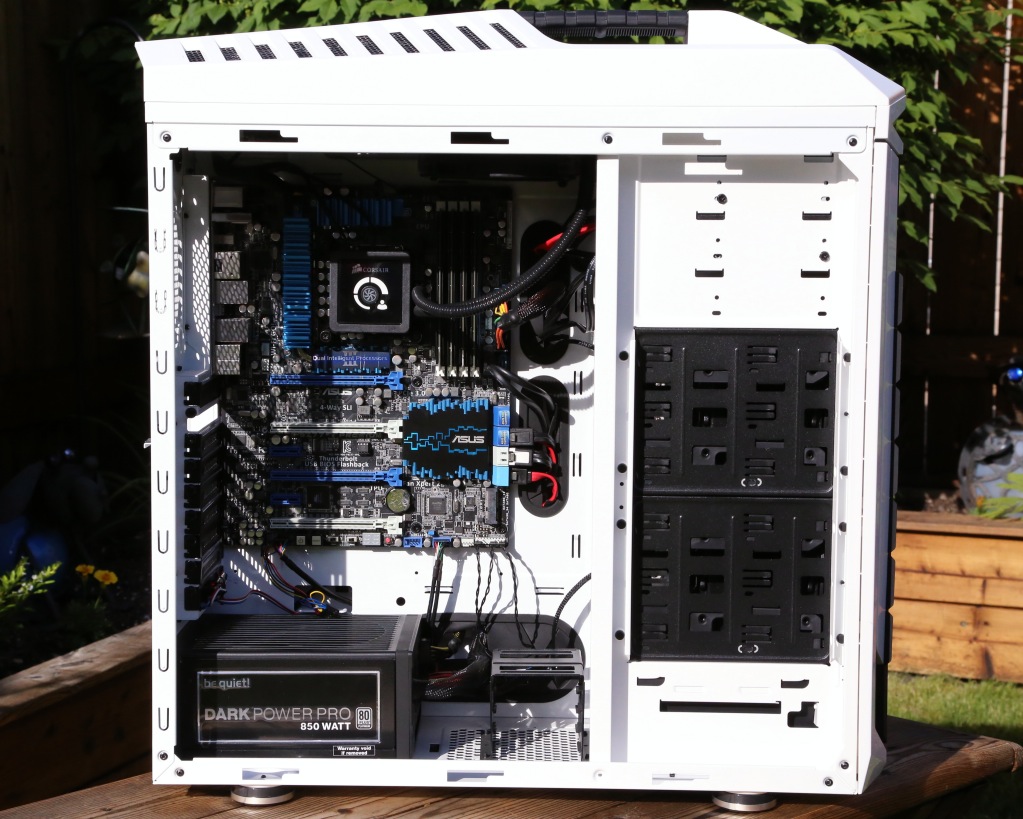THE SSD REVIEW TESTING PROTOCOL
At The SSD Review, we test our storage devices slightly different depending upon the device’s marketed purpose. Our goal is to test in a system that has been optimized with our SSD Optimization Guide, however CPU C State alteration may or may not have occurred depending on the motherboard and BIOS configurations. Benchmarks for our tests are that of fresh devices, so that we can verify that the manufacturer’s specifications match the device. Additionally, we also try to include links to the benchmarks used in our report so that you as the reader can replicate our tests to confirm that your device is top-notch.
SYSTEM COMPONENTS
This Test Bench build was the result of some great relationships and purchase; our appreciation goes to the below mentioned manufacturers for their support in our project. All of the components we use for testing and evaluation can be easily purchased at a relatively affordable price. The links provided below can assist in pricing, as well as availability for those of you who may find interest in our equipment.
| PC CHASSIS: | Cooler Master CM Strom Stryker Chassis |
| MOTHERBOARD: | ASUS P8Z77-V Premium Motherboard |
| CPU: | Intel i7 3770K CPU |
| CPU COOLER: | Corsair H100 CPU Cooler |
| POWER SUPPLY: | be quiet! Dark power Pro 850W |
| SYSTEM COOLING: | be quiet! Silent Wings 2 Chassis Fan |
| MEMORY: | Crucial Ballistix Dual Channel DDR3 Memory |
| GRAPHICS CARD: | N/A |
BENCHMARK SOFTWARE
The software used for today’s analysis is typical of many of our reviews and consists of Piriform Speccy, ATTO Disk Benchmark, Crystal Disk Mark, and Quickbench. In consumer reports, we prefer to test with easily accessible software that the consumer can obtain, and in many cases, we even provide links. Our selection of software allows each to build on the last and to provide validation to results already obtained.
PIRIFORM SPECCY
Piriform Speccy is a great tool for checking the status and health of your computer system. It provides you with brief summary, or a detailed look, at your operating system, CPU, RAM, motherboard, graphics, storage, optical drives, audio, peripherals and network.
Speccy shows us that the Kingston SDXC memory card has a total capacity of 256 GB, yet the actual amount usable storage is 238 GB. Since the capacity is larger than 64 GB, we can see that the file format is exFAT.
ATTO Disk Benchmark is a relatively easy-to-use benchmark tool, which happens to be the benchmark of choice for many manufacturers. ATTO uses compressible data rather than random data, which results in higher performance and thus, higher benchmark scores. In our testing, we have selected the transfer size to range from 0.5KB to 8192KB, and have set the total length of the test to be 256MB.
Our first benchmark test proves our Kingston memory card is up to the challenge, exceeding both its listed read and write specifications. It is important to remember that unlike the typical system SSD, SD cards are not used for the storage, execution and saving of smaller system files. SD cards are built for larger media files such as photography and video, these types of files are highly incompressible in their makeup and ideal for this Kingston SDXC memory card.
CRYSTAL DISK MARK VER. 3.0.3 x64
Crystal Disk Mark is visually straightforward, and is used for measuring the speeds at which your storage device reads and writes in both compressible (oFill/1Fill) and random, mostly incompressible, data. Random data is more consistent with everyday use of a computer, such as transferring videos, pictures and music. We run the benchmark twice, using oFill data first, and then proceeding to test with random data. Since results typically return with nearly identical scores, we only include the results for random data samples.
Now switching to a benchmark that can utilize incompressible data, the Kingston SD card actually improves from its previous performance with ATTO. Both speeds are well exceeding the listed performance!
 The SSD Review The Worlds Dedicated SSD Education and Review Resource |
The SSD Review The Worlds Dedicated SSD Education and Review Resource | 


I wish sdcard (micro and normal sized) would have better random performance. Yes, i know they are usually not indended for that kind of workload, but with more and more phones and tablets coming out (and already in the wild) with little space (like 32GB or less) it would be great if expandable memory would atleast sorta match integraded eMMC performance wise.
I understand you frustrations but the issue is that the controllers on SD and microSD cards are nowhere near a match to those on eMMC or even low end SSD`s …
True, but nothing is stopping manufacturers to use eMMC grade controllers on SD cards.
Really , that sounds fascinating . Which manufacturers SD cards have these controllers ?
None, that i’m aware of.
Random performance is not really something, that is sought after in sd cards.
Fine publish. My idea for performers is to select the righties organization for projection like SD Memory Cards